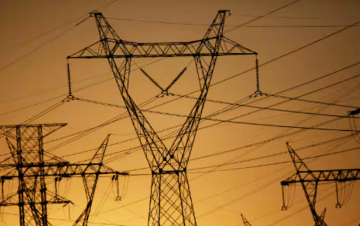
Land degradation
Indian agricultural farms are increasingly staring at a crisis, with over
29 percent (96.4 million hectares) of India’s total geographical area (328.7 million hectares) being degraded, roughly 2.5 times the size of India’s largest state, Rajasthan. The numbers highlight the stiff challenge India must face to achieve its target of becoming land-degradation-neutral by 2030, as
announced by the Prime Minister in September 2019 at the UN Convention to Combat Desertification. It can take 500 to 1,000 years for one inch of topsoil—the upper layer of soil containing the most organic matter and microorganisms—to form. Soil erosion has always occurred naturally, but today, topsoil loss from erosion due to agriculture surpasses the rate of soil formation.
Agriculture is the most dominant contributor to water stress, and as much as 91 percent of our freshwater is now used in the agriculture sector.
To make matters worse, India faces a severe water crisis. Almost 17 states/Union Territories have been
categorised as ‘over-exploited’, where the annual ground water extraction is more than the annual extractable ground water resource. According to Falkenmark’s Water Stress Index, about 76 percent of Indians face water scarcity. Agriculture is the most dominant contributor to water stress, and as much as 91 percent of our freshwater is now used in the agriculture sector.
Ecological poverty and loss of soil organic carbon
So far, all the wins for reducing income poverty could be undone by growing
ecological poverty which is the “lack of an ecologically healthy natural resource base that is needed for a human society’s survival and development”. The Indian smallholder farmers
constitute 86 percent of the farmers in the country, with an
average land holding of 1.08 hectares. They are most vulnerable to ecological poverty. In the last two decades, India’s agricultural sector has suffered negative total revenues. The small size and low profitability do not allow smallholder farmers to deploy relevant technologies to fight climate change, instead, they are forced to increase yields through unsustainable practices like deforestation, overgrazing, intensive soil tillage, monoculture cropping, bare fallowing, and heavy reliance on the use of chemical fertilisers and biocides. These practices damage the microorganisms which makes the soil fertile, carbon-rich. Scientific organisations like the Intergovernmental Panel on Climate Change are concerned about such practices because they
increase the emission of greenhouse gases (GHG). Agriculture already
contributes 25-30 percent of the total GHG emissions, globally.
Regenerative agriculture: A potential solution
A consensus is emerging among soil scientists that regenerative agriculture holds enormous potential to restore soil health and productivity in degraded landscapes while delivering financial benefits to smallholder farmers. It also improves water use and efficiency by enhancing the health and nutrient-holding capacity of the soil. Studies have established that a 1-percent increase in soil organic matter per 0.4 hectare (ha) increases water storage potential by more than 75,000 litres
. There is now evidence from long-term field experiments globally that proves regenerative agricultural practices can significantly increase soil organic carbon stocks.
The Government of India, as part of its climate commitment, has begun promoting several regenerative agriculture principles through
National Mission for Sustainable Agriculture.
The Government of India, as part of its climate commitment, has begun promoting several regenerative agriculture principles through National Mission for Sustainable Agriculture.
Defining regenerative agriculture
Regenerative agriculture is commonly
defined as a “way of farming to build and improve soil fertility, whilst sequestering and storing atmospheric CO
2, increasing on-farm diversity and improving water and energy management”. It is increasingly getting standardised with different voluntary schemes offering third-party certifications from audit agencies. The main standards operational in India are
regenagri and
Regenerative Organic Certified®. Regenagri is developed jointly by the world’s oldest sustainability organisation Solidaridad, and global certification organisation—Control Union, and has so far brought 1.25 million acres of land under regenerative practices. Several food businesses like Unilever, Nestle, etc. are also developing business-specific regenerative agriculture standards.
Debates on soil carbon credits through regenerative agriculture
There is much
debate on the potential of regenerative agriculture to store carbon in the soil. Some studies doubt the durability of Soil Organic Carbon (SOC) and challenge satellite-based measurement techniques. Some suggest sequestering carbon via agroforestry is a more foolproof method than SOC. But such critiques need to pay attention to several scientific papers that
establish an estimated potential of 1.5 gigatons of carbon (GtCO2) per year for cropland sequestration globally, or approximately 55 GtCO2 over a mid-range saturation period of 35-40 years. The potential for carbon removal increases further if practices like composting municipal food waste, tree cropping, hedgerows and other cropland buffers, and pasture restoration or biochar are included in the calculation
. Regenerative agriculture, therefore, can and should play a significant role in tackling climate change, with the potential to remove
100-200 GtCO2 by the end of the century which is several times more than the present level of emissions.
How do small Indian farmers benefit from regenerative agriculture?
There are four fundamental benefits for Indian small farmers opting for carbon sequestration using regenerative agricultural practices. Firstly, SOC helps restore degraded soils using less water, improving farmers’ agricultural productivity while reducing costs due to reduced use of fertilisers and chemicals. Secondly, healthier soils make farms more resilient against droughts and heavy rainfall. Thirdly, the process can generate additional income from the rapidly expanding voluntary carbon credit markets. A carbon credit is a certificate equivalent to 1 ton of carbon that permits the emission of one ton of greenhouse gases per certificate.
Many FMCG companies are asking farmer suppliers to adopt targets to cut emissions using regenerative agriculture and prioritising partnerships with new suppliers who already have regenerative practices in place.
As per Solidaridad’s field analysis, a smallholder farmer in India can potentially sequester 1 tCO2 (1 ton of carbon) to 4 tCO2 by adopting regenerative practices on 1 hectare of land. Per ton of carbon, today is priced at INR 1500 to INR 2,500 (EUR 15-20), which could be a
significant revenue source for the farmers. Fourthly, many FMCG companies are asking farmer suppliers to adopt targets to cut emissions using
regenerative agriculture and prioritising partnerships with new suppliers who already have regenerative practices in place. Smallholders who are traditionally excluded from high-value supply chains would be able to grow inclusively by becoming regenerative farmers.
Solidaridad Asia’s field experience with regenagri certification supporting more than 13,000 cotton smallholder farmers in Vidarbha, Maharashtra, dispelled the myth that regenerative agriculture reduces yield. In 2020-22, the project achieved a 20 to 30 percent increase in yield, a 30-percent reduction in input costs and a 3percent price premium from the market. Similar results were witnessed in pilots with palm oil smallholders in Malaysia, Indonesia, and India; sugar, soy, and coffee smallholders in India; and mango farmers in Bangladesh.
Four hurdles for regenerative agriculture and potential solutions
At present, much interest in regenerative agriculture is driven by the high carbon prices in the European Union that
hit 100 euros (US$ 106.57) per ton earlier this year. The more emitters have to pay for EU carbon permits to cover each ton of C0
2 they produce, the greater the incentive to invest in low-carbon farming methods like regenerative agriculture. “The
annual demand for voluntary carbon credit in India is expected to touch 500+ million tCO2 by 2030”.
However, there are some potential challenges which could derail this positive movement. First, it is necessary to recognise that farmers are the producers and owners of carbon. There should be mechanisms for trading in SOC using the principles of Fair Trade that calculate a minimum price that ensures the average costs of the projects will be covered, plus an additional “Fairtrade Premium” goes directly to the local community to fund activities that help them become more resilient through regenerative agriculture.
The subsidies for smallholder farmers could be extended to certification bodies enrolled with the Quality Council of India—the national accreditation body for certifications in India.
Second, in August 2022, India revised its carbon credit policies to ban the export of carbon credits. As per the
new policy, “carbon credits are not going to be exported. These credits will have to be generated by domestic companies, bought by domestic companies.” Such a policy would limit the options for smallholder farmers. These farmers took lower prices for decades to keep the consumer prices stable and were not allowed to export food at higher prices. If we stop them from storing carbon on their land and export at least part of the carbon in the form of carbon credits at higher prices, they will lose out again.
Third, the Government may consider schemes like
Paramparagat Krishi Vikas Yojana to be extended to regenerative agriculture farmers. The certification costs for regenerative agriculture and carbon verification are steep. The subsidies for smallholder farmers could be extended to certification bodies enrolled with the Quality Council of India—the national accreditation body for certifications in India.
Fourth, the mushrooming of different regenerative standards can derail the credibility of the regenerative agriculture movement and affect smallholder farmers. There is a necessity for urgently developing a set of common values for regenerative agriculture standards, their certification protocols, systems and tools with a focus on the positive impact on farmers as well as climate.
Conclusion
Climate change mitigation, food security, climate resilience, biodiversity, and soil health are all interrelated and these could be collectively achieved through regenerative agriculture. In this COVID-affected decade, Indian agriculture stakeholders must redesign agriculture the way it was done in the 1960s, which ushered in the Green Revolution. We don’t have much time to regenerate and revive our soil and avoid the depletion of water resources. On the other hand, regenerative agriculture is good for the people, the planet, and profit.
Shatadru Chattopadhayay is Managing Director, Solidaridad Asia.
Renee Cho, “Why Soil Matters”, State of the Planet Journal, Columbia University, April, 2012
Kayatz, B., Harris, F., Hillier, J., Adhya, T., Dalin, C., Nayak, D., et al. (2019). “More crop per drop”: exploring India's cereal water use since 2005.
Sci. Total Environ. 673, 207–217. doi: 10.1016/j.scitotenv.2019.03.304
Anamika Yadav, Down to Earth, December 2022
Poeplau, C. & Don, A. (2015). Carbon sequestration in agricultural soils via cultivation of cover crops–A meta- analysis.
Agriculture, Ecosystems & Environment 200:33- 41
Roe, S. et al. (2019). Contribution of the land sector to a 1.5 °C world. Nature Climate Change. 9, pp. 817–828
The views expressed above belong to the author(s). ORF research and analyses now available on Telegram! Click here to access our curated content — blogs, longforms and interviews.




 PREV
PREV


